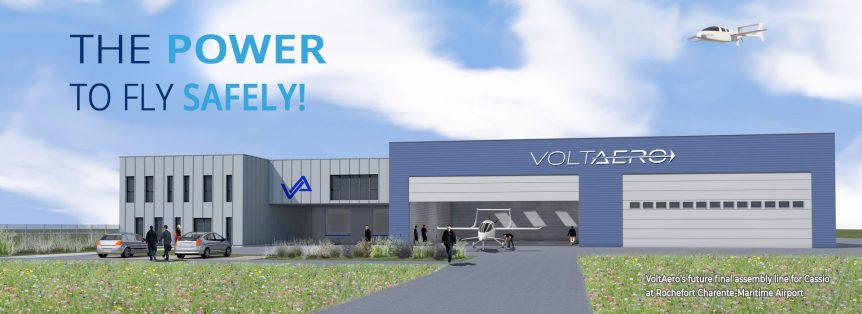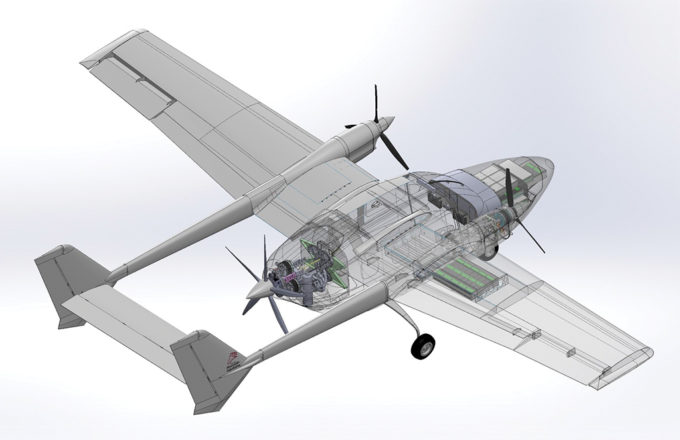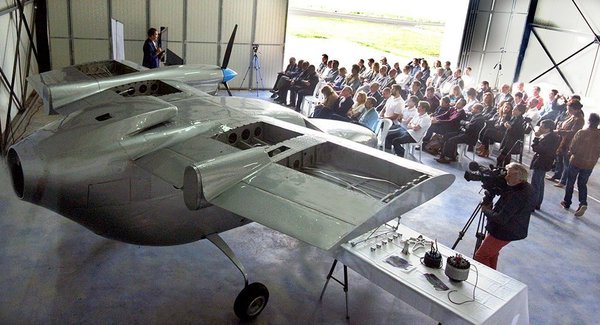At least two Cessna 337s are flying on modified power systems – one with Ampaire in various locations around the world and one in France. VoltAero’s French Cessna push-pull twin has been turned into a tri-motor, with twin motors sprouting from the front of the craft’s tail booms. Like its American counterpart, VoltAero’s machine is a test bed for the planned power system that will mark its successor. VoltAero reveals its coming aircraft will feature a “barrel”-type arrangement of three 60 kilowatt electric motors ringing a central internal-combustion (thermal) engine. Jean Botti, CEO of VoltAero, explains the motor configuration is well-proven, having flown in the Cassio 1 demonstrator (the Cessna) since October last year. Since then, it’s been flown around a series of airports in France, racking up over 3,000 kilometers (1,864 miles) in 10 hops visiting 11 cities. Later versions of the Cassio design will feature the 330 kW hybrid arrangement of Cassio 1, producing 442 horsepower. Later versions …
VoltAero Has Ambitious Plans
VoltAero is a small French company that might succeed in electric flight where bigger firms have failed. Its hybrid-electric system marks an innovative path to quiet flight. Airbus ventured into electric aviation with a four-motor conversion of the Colomban cri-Cri in 2010 and a clean-sheet craft, the E-Fan, a sleek, essentially ducted fan two-seater in 2015. Initially big plans for production of two and four seat variants bloomed – then withered. Airbus dropped plans for the personal electric airplane market and instead concentrated on at least three versions of Urban Air Mobility devices and a hybrid-electric demonstrator based on a BAE 146 airliner. This last project, the E-Fan X, was canceled recently. Jean Botti was Chief Technology Officer for Airbus, and Didier Esteyne a test pilot for the Cri-Cri and E-Fan. Botti is now CEO of VoltAero: Esteyne its Technical Officer. VoltAero has ambitious plans for its hybrid electric future, and management experience to pull them off. Flying VoltAero’s unique …
Volt Aero Cassio Hybrid – From France
You may have noticed an ongoing divide in electric aircraft philosophies, that of designing from a blank sheet, or that of converting an existing airplane from fossil fuel to electric power. French company VoltAero has chosen the second path with its Cassio. A conversion of a Cessna 337 Skymaster, it shares similarities to Ampaire’s 337 conversion, with significant differences in its power configuration. What has Five (Three?) Motors and Three Propellers? Ampaire’s 337 conversion retains the “push-pull” arrangement of the original, with the “pusher” an electric power unit behind the cabin and between the twin tail booms. VoltAero’s replaces the front engine with a faired, engineless nose and one REX 60-kilowatt (80.4 horsepower) electric motor on the nose of each boom. According to Flyer magazine, Cassio 1 now has a single electric motor coupled to an internal-combustion engine bringing up the rear. “The prototype Cessna-based Cassio has two 60kW motors driving two forward facing propellers on the wing. A hybrid …
Airbus e-Fan Prepared Well for Today’s Cross-Channel Flight
106 years after Louis Bleriot took off into a foggy morning and pointed the nose of his Model XI toward the Dover coast, Airbus celebrates the event with an anniversary flight of their e-Fan prototype, now sporting a bigger, more powerful battery pack, lightened airframe and lighter electrical components. Their press release carefully avoids mentioning Hugues Duval’s flight the day before, apparently done to upstage the e-Fan’s trip. It does claim credit for making the first cross-channel flight in a “twin-engine electric plane,” even though Duval’s Cri-Cri was powered by twin Electravia motors. “At 11am on a calm, sunny summer morning, the Airbus E-Fan touched down in Calais to enter its name in the record books. The all-electric plane became the first twin-engine electric plane taking off by its own power to negotiate the English Channel, more than 100 years after Louis Blériot had first made the intrepid journey. “Travelling in the opposite direction to the pioneering Frenchman and powered by lithium-ion …
EADS Developing Line of Production Light Electric Aircraft
European Aeronautic Defence and Space Company (EADS) has been heating up some batteries lately, announcing production plans for the E-Fan prototype unveiled at the 2012 Paris Air Show and showing a four-seat derivative, the 4.0. Both share the twin-motor ducted fan configuration that makes the trainer and light electric airplane look like an A-10 Warthog, but with much less fearsome aspects. Tony Osborne, reporting in the May 8 online Aviation Week and Space technology, reports, “To produce Europe’s first wholly electric-powered aircraft the Airbus Group is partnering with French industry and entering the light aircraft market. A new subsidiary, VoltAir [lovely French pun], will be set up in the coming months to develop and produce the two-seat E-Fan 2.0 and the four-seat E-Fan 4.0. The two models are being aimed at the general aviation market, and officials say prices will be competitive with those of current piston-engine light aircraft—around $300,000—but with operating costs that are less than a fraction of …
EADS Pulls Off Electric Hat Trick at 2011 Paris Air Show
At the 2011 Paris Air Show at Le Bourget this week, the European Aeronautic Defense and Space Company N.V. (EADS) showcased at least three electric flight vehicles – two emonstrating current reality and one pointing toward a cleaner future for short-to-medium range airliners. Cri-Cri, the four-motored, contra-rotating props on stalks aerobatic wonder, did indeed perform at the 2011 Paris Air Show, doing six-minute routines daily at the show. Didier Esteyne, the plane’s obviously accomplished pilot, explains things in this video. http://www.youtube.com/watch?v=76h4VA3yoNI Emmanuel Joubert, Program Head for the All-electric Cri-Cri at EADS, explained the plane’s advantages. “In all-electric mode, the plane’s performance during climb and aerobatics is better compared to a conventional aircraft of this type. This allows the pilot to really have ‘fun flying’ – with no noise and high torque at low and high speed.” Because of the light weight and small size of the Cri-Cri, initial flights were limited to 20 minutes, but now run 30 minutes, with …
Would You Believe There Are Two Electric Cri-Cri’s?
EADS, the Airbus people, gained a high degree of publicity with their four-motor Cri-Cri, as reported here previously, but a new contender has outraced it. Didier Esteyne flew the EADS plane for the press and showed it to good advantage. His mount was powered by four 15-horsepower electric motors, paired in pods on either side of the plane’s nose. The contra-rotating propellers gave a good performance judging from the in-flight video. EADS’ 60 total horsepower gave it a top speed of 141 miles per hour, but that was eclipsed by another electric Cri Cri, this one with a single 25-horsepower Electravia brushed motor on each stalk. Bigger motors swinging bigger propellers gave it a speed advantage and a world record of 262 kilometers per hour (162.44 miles per hour) , easily topping the Italian ENFICA-FC’s 135km/hr (83.7 mph) set earlier this year. Propellers were made by E-Helice, a part of Electravia, headed by Anne Lavrand, who also founded APAME, the French Association For the Promotion of Electric Aircraft. …
Smallest Four-Motor Electric Plane Flies
For a company that employs over 119,000 and has annual revenues approaching 43 billion Euros ($55 billion), the Cri-Cri (Cricket) seems a minuscule part of their enterprise, but garners a huge share of publicity. Reporters and photographers flocked to Le Bourget field near Paris on September 2 to record the first flight of the petite creation. The EADS (European Aeronautic Defence and Space Company N.V.) press release explains the excitement. The all electric Cri-Cri, jointly developed by EADS Innovation Works, Aero Composites Saintonge and the Green Cri-Cri Association has made its official maiden flight at Le Bourget airport near Paris on Thursday. This Cri-Cri is the first-ever four-engined all-electric aerobatic plane. The event has been supported by the French Musée de l’Air et de l’Espace. The plane became airborne at 11:12 CET. Take-off and climb were smooth, no vibrations could be felt and manoeuvrability was excellent. All systems performed well and the plane returned safely after 7 minutes. “This aircraft …



